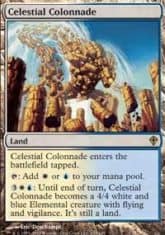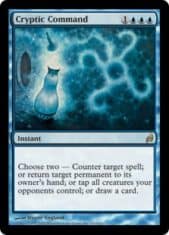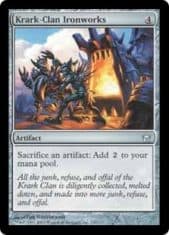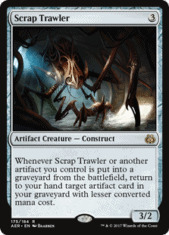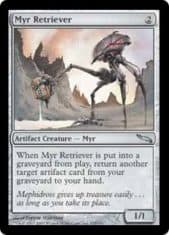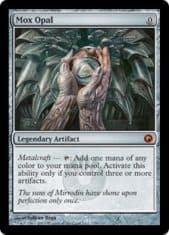It’s no secret that I’m a big fan of Detroit, so despite this being my fourth weekend of major events in a row, I was eager as ever for this nice little road trip to play some casual friendship Modern. The food there is great, and Michigan has some of the best beer on the continent. I teamed up with seventeen-time Pro Tour competitor Ryan Sandrin as well as “member of the press” Keith Capstick for this Unified Modern event and spent the better part of the previous month being bullied by my teammates. You see, they wouldn’t let me register [Card]Celestial Colonnade[/Card], my biggest fling, preferring that I “win” matches rather than “lose” them. I don’t understand, since the only true joy in Modern is resolving the card [Card]Cryptic Command[/Card] then losing the game on the following turn because your deck sucks. Keith was locked in to playing Humans, and Ryan would invariably play some atrocious [Card]Bridge from Below[/Card] deck, so I decided to pick up the format’s latest boogeyman: [Card]Krark-Clan Ironworks[/Card].
KCI is a deck based on working-class solidarity and the power of factory unions. The [Card]Scrap Trawler[/Card]s and the [Card]Myr Retriever[/Card]s work together at the [Card]Krark-Clan Ironworks[/Card] to deliver victory after victory for the proletariat. They win hard-fought battles against all the heinous tricks the bourgeoisie throws at them, from [Card]Stony Silence[/Card] (cop) to counterspells (cops) to [Card]Thalia, Guardian of Thraben[/Card] (literal cop). Much as Marx posited the inevitable end of capitalism, [Card]Pyrite Spellbomb[/Card] will invariably turn union labour into victory. Much of the Red Scare surrounding KCI can be attributed less to the resilience of its combo, and more to the impact inexperienced players can have on tournament structures. If you don’t know what’s going on or fail to identify shortcuts and loops, the deck can feel like Eggs, and the myriad of necessary game actions and explanations can cause rules enforcement nightmares.
Memes aside, I put a lot of work into learning to play this deck for GP Detroit, and I’m here today to share the preparation that gave me a very high win-rate over the several events I’ve played with the deck so far.
Like many linear decks in non-rotating formats, the popular version of KCI was developed by a cabal of sinister yet dedicated Magic players — in this case Matt Nass and friends — and I figured I would do well to adopt their latest list and not make any changes I wasn’t extremely comfortable with. This probably works as good advice across much of the spectrum of linear strategies, be it the fabled Amulet Titan group chat or a Legacy Storm Facebook group: believe in the group consensus and learn from them before getting cocky and screwing things up. Things are probably there for a reason. I read Matt’s article going over the basics of the deck and its sideboarding, despite it featuring an out-of-date decklist, memorized the different game-ending loops, and set out to Face to Face Games Toronto to practice explaining to my Tuesday night Modern opponents how those loops worked. You see, there’s more to this deck than merely playing your cards correctly: you also have to navigate your opponent. Most people at this point are familiar with the deck’s combo process, but given that match completion will frequently require establishing shortcuts with [Card]Mox Opal[/Card] activations over long, drawn-out combos and can only end with an explanation of the minutia of your often-complex [Card]Myr Retriever[/Card] loops, you’re invariably going to end up with some people justly questioning what exactly is going on. I figured that local Modern weeknight events were going to be the best place to train this unique skill, and I was right — my very first opponent had never seen the deck before and, despite being very nice, was confused at the concept of demonstrating a loop as a repeatable action in tournament Magic. No fault to him, the way KCI interacts with unique rules is obnoxious at best, from exploiting the way spells are technically announced and paid for to this loop issue. Be prepared to explain your combo properly, and if you’re a judge with a Modern event coming up, read up on the minutia relevant to KCI. It’s important.
I brought the deck to a 10th place finish at the most recent FacetoFaceGames.com Toronto Open, narrowly missing the cut after losing to the difficult [Card]Devoted Druid[/Card] combo matchup. I kept crushing weeknight events with the deck, winning close match after close match, and eventually started off the GP with a solid record despite a late pair of close losses to decks like Infect. Ryan’s deck didn’t show up to play, however, and we were dead in the water by the end of Round 7. I signed up for the PTQ, added some [Card]Ghirapur Aether Grid[/Card]s to my sideboard — which were terrible — and crossed my fingers for a better showing. These essentially single-elimination events are rough, and the stakes are high. I was lucky enough to start off 5-0 and be one of the rare tables able to draw the sixth round, though my low seed ensured that I’d be on the draw throughout the elimination rounds. I took down a very friendly opponent who flew in from Denver on Humans in the quarterfinals before getting absolutely ranched by a pleasant Texan on Bant Spirits in the semis. To say that I felt inadequately prepared for that matchup is to do a disservice to the humble art of the euphemism. Let’s talk strategy.
Ironworks Combo, by Ben Stark – 2nd place, PT 25th Anniversary
[deck]
[Lands]
3 Buried Ruin
4 Darksteel Citadel
2 Forest
4 Grove of the Burnwillows
2 Inventors’ Fair
3 Yavimaya Coast
[/Lands]
[Creatures]
2 Myr Retriever
4 Scrap Trawler
[/Creatures]
[Spells]
4 Ancient Stirrings
3 Engineered Explosives
4 Mox Opal
3 Chromatic Sphere
4 Chromatic Star
2 Pyrite Spellbomb
4 Terrarion
4 Ichor Wellspring
4 Mind Stone
4 Krark-Clan Ironworks
[/Spells]
[Sideboard]
1 Island
4 Lightning Bolt
4 Nature’s Claim
3 Negate
3 Sai, Master Thopterist
[/Sideboard]
[/deck]
Not much has changed with this deck since the addition of [Card]Sai, Master Thopterist[/Card] to the sideboard. The mana in the maindeck now supports the blue sideboard cards, and people are being creative with the kinds of counterspells, disenchant effects, and removal played in the sideboard, but the philosophy largely stays the same. This particular sideboard is adequately prepared to answer a high density of disruptive Humans decks, slow control decks like U/W or Jeskai, and incidentally has eight excellent answers to [Card]Eidolon of the Great Revel[/Card] against Burn. I ran this sideboard over the entire course of the month preparing for the GP and was satisfied enough with it that I ran it at the GP itself. Over the course of Sunday’s PTQ, however, I found it lacking against some of the more diverse strategies that Modern has to offer. Yes, I had coherent plans against many of the most popular decks, but I felt dumbfounded in my semifinals loss to Bant Spirits. I wasn’t sure how to overcome a wide swath of problematic cards, from [Card]Unified Will[/Card] to [Card]Stony Silence[/Card] with [Card]Spell Queller[/Card] and Thalia. Sai certainly wasn’t effective against their assault of creatures, and [Card]Negate[/Card] was much too slow an answer to the counterspells protecting their [Card]Stony Silence[/Card] with the amount of pressure being put on me. I felt like I needed all 15 sideboard cards for their specific utilities in the matchup, but was playing a combo deck that could never board that many in.
I set out to find an alternative set of broad answers that could turn this matchup around and grant me edges elsewhere. Experience in tow, I felt confident that I could analyze prospective technology. Before the event, I had dismissed the [Card]Swan Song[/Card]s out of the sideboard of this Shintaro Ishimura PTQ list as worse [Card]Negate[/Card]s in a format where the mirror could exist, but neglected to realize some of the upsides of the card. You see, not only does it beat opposing counterspells for a single mana, but it’s a crucial answer to [Card]Stony Silence[/Card] and [Card]Collected Company[/Card] — all three of which are problems that need solving in the Bant Spirits matchup. The leftover bird token doesn’t matter very much, given that you’re probably about to kill them. Yes, it’s worse than Negate in the mirror, but there are infinitely more Stony Silences than Krark-Clan Ironworks floating around these days. Another innovation was spotted at GP Detroit — [Card]Firespout[/Card]. The post-board games you lose against Humans are the ones where they’re able to play a stream of disruptive two-drops while pressuring you with a [Card]Champion of the Parish[/Card] or [Card]Mantis Rider[/Card]. [Card]Firespout[/Card] might not a kill a too-large Champion, but it can save you from death in pretty dramatic ways, while also being a powerful spell against a lot of other, less difficult matchups.
Here’s the sideboard I’d register going forward, and consider adding a [Card]Spire of Industry[/Card] or [Card]Glimmervoid[/Card] or two to your maindeck to support all these coloured spells:
[deck]
[Sideboard]
2 Swan Song
3 Sai, Master Thopterist
2 Galvanic Blast
2 Lightning Bolt
4 Nature’s Claim
2 Firespout
[/Sideboard]
[/deck]
Good luck! With my little competitive Modern season over, I’m going to go back to figuring out how many more win conditions I can cut from Jeskai so I can fit in extra [Card]Hieroglyphic Illumination[/Card]s. Actually, never mind the luck thing. I need all I can get.

